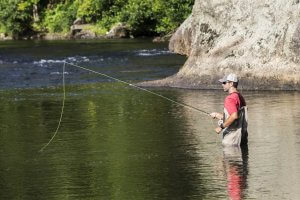Fly fishing can be an overwhelming sport, with many traditions and techniques, casting and presentation can get confusing. However, once you have established a set of patterns or techniques for casting it can easily become second nature.
Fly Casting Techniques
 Anglers shy away from casting properly due to old habits or not thoroughly understanding a handful of tips and techniques that are critical to getting the perfect cast. While perfect presentation won’t happen overnight, it should be an exciting learning experience for all involved. With time spent on the water, casting in open spaces and even under obstacles, your fly line will find its way soaring to hit a dime.
Anglers shy away from casting properly due to old habits or not thoroughly understanding a handful of tips and techniques that are critical to getting the perfect cast. While perfect presentation won’t happen overnight, it should be an exciting learning experience for all involved. With time spent on the water, casting in open spaces and even under obstacles, your fly line will find its way soaring to hit a dime.
While many books can tell the tale of casting properly and illustrating proper techniques to nail the perfect cast, it simply takes time and effort spent practicing.
In this article Southern Appalachian Anglers points out a handful of useful techniques to casting properly to achieve that perfect cast.
The Perfect Cast
Holding the rod properly is met by two different ways. This method is solely on what is more comfortable to the angler.
- Thumb on top grip – helps prevent wrist break. More difficult to cast a longer line.
- Index finger on top grip – allows unimpaired movement when casting. Loose holding.
Two Main Casting Objectives
When casting a fly rod you will want to achieve a tight loop, this can be formed by maintaining a straight line path and continuously accelerating the rod-tip to a stop. While performing your casting stroke (the distance that the rod hand travels from the beginning to the end of the cast) the rotation of your hand, wrist, and arm should make the rod flex in one single motion. That motion should remain straight in order to deliver a tight presentation.
Handy Casting Rules
- Follow a straight path with the rod-tip from the beginning of the stroke to the end.
- Eliminate any slack in the fly line. This will help achieve a tight loop.
- Pause at the end of each casting stroke to allow the fly line to unravel or make a loop.
- Do not solely use your wrist to make a stroke.
- To generate sufficient energy the fly rod my make a sudden stop.
When teaching yourself fly casting techniques, perform a number of false casts. This will provide your memory with correct strokes and when to stop the stroke. Do this over and over until you can see where your rod starts and stops. False casts will also help you understand the amount of slack line you need out before beginning a new cast.
Once you are familiar with the technique, start focusing on your back cast (where your stroke stops). This will help you analyze your loop – if it is tight or if it is too loose. Remember: Achieve a Tight Loop!
Southern Appalachian Anglers – Fly Fishing Class
To learn more about fly casting and fly fishing visit Southern Appalachian Anglers online. SAA offers a number of different fly fishing schools that provide anglers with the skills and knowledge needed to perform the perfect presentation.
